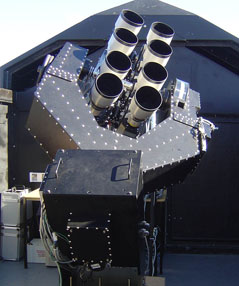Compound Eyes Find New Planets
Have you ever wondered what makes it so hard to swat a fly? Well, one of the reasons is that they have evolved compound eyes that can look in thousands of directions at once, and a neurological framework connecting those compound eyes to specialized portions of their little fly brains tuned specifically to detect motion. So they see you coming from every direction.

The anatomy of these compound eyes is really quite amazing, with each segment (see the micrograph above, credit to the University of Oulu Institute of Electron Optics) comprising an individual single-lens photo-sensor pointing in a different direction, with a dedicated neuron for each sensor tuned to detect variations in brightness.
As it turns out, these are precisely the characteristics that astronomers find themselves emulating in order to conduct a comprehensive search for planets circling other stars. Not knowing which of the billions of stars in the sky might harbor means that they have to look in all directions at once, and the technique of detecting the minute variations in a star's brightness due to a tiny planet transiting across its face requires extreme sensitivity to brightness changes.
So it probably wouldn't surprise you to discover that the latest planet-finding champion is the new SuperWASP compound telescope.
The latest news from the UK's leading extra-solar planetary detection program is that they just detected two new planets circling other stars, and are hot on the trail of others. The SuperWASP scope was used to find the planetary candidates and determine their radii, and then the SOPHIE spectroscope at the Observatoire de Haute-Provence confirmed the candidates and weighed them by detecting the slight wobble of the star due to the planet's gravitational pull (through the Doppler shift of the star's spectrum in it's tiny orbit around the planet).
In contrast to our 200 or so earlier extra-solar planetary discoveries which required extreme telescopes costing hundreds of millions of dollars and laborious one-at-a-time planetary searches, SuperWASP looks at hundreds of thousands of planets at a time using rather modest small-diameter wide-field optics and CCD cameras.
Here's to hoping that SuperWASP's record of finding two new planets in its first four days of operation continues!
So it probably wouldn't surprise you to discover that the latest planet-finding champion is the new SuperWASP compound telescope.
The latest news from the UK's leading extra-solar planetary detection program is that they just detected two new planets circling other stars, and are hot on the trail of others. The SuperWASP scope was used to find the planetary candidates and determine their radii, and then the SOPHIE spectroscope at the Observatoire de Haute-Provence confirmed the candidates and weighed them by detecting the slight wobble of the star due to the planet's gravitational pull (through the Doppler shift of the star's spectrum in it's tiny orbit around the planet).
In contrast to our 200 or so earlier extra-solar planetary discoveries which required extreme telescopes costing hundreds of millions of dollars and laborious one-at-a-time planetary searches, SuperWASP looks at hundreds of thousands of planets at a time using rather modest small-diameter wide-field optics and CCD cameras.
Here's to hoping that SuperWASP's record of finding two new planets in its first four days of operation continues!
























No comments:
Post a Comment